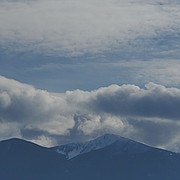Clouds indicate daily weather forecast
“The air up there in the clouds is very pure and fine, bracing and delicious. And why shouldn't it be?--it is the same the angels breathe.” ~ Mark Twain (1835-1910)
Almost everyone watches clouds, among the most fascinating and easily observed of all weather phenomena. One of the first things I do every morning is look outside and see what type of day it’s going to be. I always hope for bluebird days filled with sunshine, but if clouds are present I take a guess at what the day might be like. Will it be overcast or rainy? Does the thin layer of high clouds indicate an incoming storm?
Clouds show us what is happening in the atmosphere-mainly that warm, moist air is rising, expanding and cooling. Since cool air cannot hold as much water vapor as warm air, some of the vapor condenses onto dust particles in the cooler atmosphere. When billions of these droplets come together in the same area, a cloud is visible.
The different types of clouds are divided into four major groups; cumulus, cirrus, stratus and nimbus.
Cirrus clouds are the thin, wispy clouds seen high in the sky. They look as if someone took a cloud, stretched it, pulling pieces off, like a cotton ball when it is pulled apart. They are thin because they are made of ice crystals instead of water droplets. A blue sky and a few cirrus clouds high in the sky, usually means it is going to be a nice day.
Cumulus clouds are the puffy clouds that are usually scattered throughout the sky. In Latin, the word cumulus means pile. Just like when we say “accumulate,” it means things pile up. This type of cloud is formed when warm air rises carrying water vapor with it by evaporation. Cumulus clouds can be white or gray. White fluffy clouds means no rain, but when they form into dark or gray clouds, it is going to rain.
Stratus clouds look like a huge thick blanket covering the sky. These clouds are a sure sign of rain if it is warm and snow if it is cold. If stratus clouds are near the ground, they form fog. These clouds form when the weather has been cold and warmer moist air blows in. The amount of moisture in the air and the difference between warm and cold air determine how thick the cloud or fog is.
The word nimbus means a cloud that already has rain or snow falling from it. These clouds are dark and seen during a thunderstorm along with thunder and lightning. They can be a combination of two clouds, like a cumulonimbus, which means a puffy black cloud with rain falling out or it, or a stratonimbus, which is a dark blanket with rain falling out of it.
Not all clouds fit into the cookie-cutter names but by looking at their appearance and height, you can at least guess what the day may be like.



